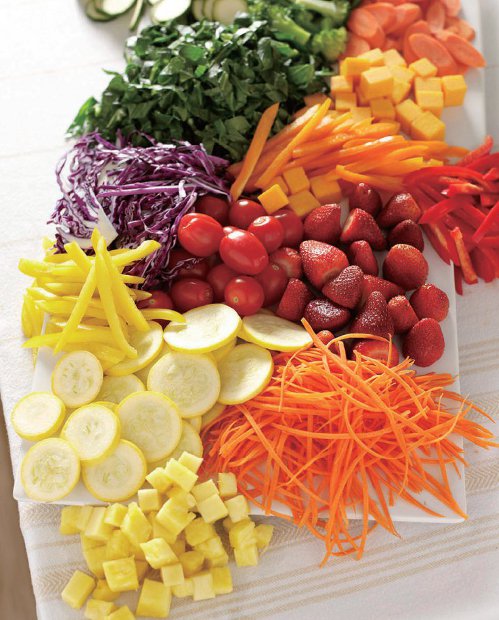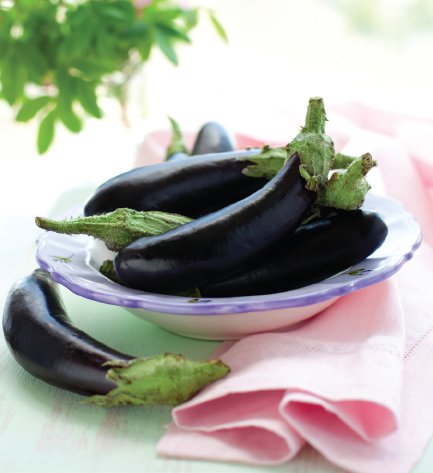
THE VISUAL PALETTE: WHAT COLOR IS YOUR FOOD?
There is a story in Oliver Sacks’s An Anthropologist on Mars, a book about true-life neurologic disorders, called “The Case of the Color-blind Painter.” It describes how an artist suffered a car accident and consequently became color-blind, as if “viewing a black and white television screen.” Of course, for a painter, this was especially hard, but of particular interest to me is that “he found foods disgusting due to their grayish, dead appearance and had to close his eyes to eat.” This man turned to black and white foods such as white rice and black olives because they appeared normal.
Food is a multisensory experience. The first thing most people say when they sit down to eat is, “That looks great.” Sometimes they are just being nice, but for the most part, people “eat” with their eyes first. Even Andrew Zimmern says on his Bizarre Foods television show, “If it looks good, eat it.” But what if it’s not so simple? Food manufacturers commonly add food coloring to foods that look “grayish and dead.” Meats and seafood are typically packaged with color preservatives and other additives to make them appear fresh. If you had to eat most meats the way they actually look, you might also want to close your eyes.
Processed and pasteurized foods, drinks, and snacks (especially items with a long shelf life) usually suffer similar treatment: a dye job to make them look more appealing and appetizing. The only thing you can count on to be exactly what it looks like is fresh raw foods, because Mother Nature lets her gray hair show; she’s not covering it up. If a potato has too many green bits, it’s moldy and past its prime.
But how stunning is her visual palette? This detox lifestyle has awarded me the gift of vision, as if I have been color-blind all these years and now I can finally see. When I create recipes, I let Mother Nature be my guide. I look for rich contrasts of color and texture to fine-tune a recipe. It’s no coincidence that foods that are rich in color are the healthiest foods on earth. For instance, dark blue and purple fruits are rich in antioxidants, while orange foods are rich in vitamin C. Dark, leafy greens are rich in folic acid and are a great source of calcium and iron, while red foods contain lycopene, a compound that helps prevent heart disease. Eating directly from the color wheel inspires culinary creativity and serves our health.
Working with Adrian Mueller, the food photographer for this book, I was able to see my recipes come to life. We chose to work with natural lighting, and the only adjustment we made to the final dishes was a spritz of water, if needed, to perk up the salads. This was a huge contrast from an earlier project when I owned a more mainstream catering company that served mostly cooked foods. Back then we needed bright, harsh studio lighting, a food stylist with a bag of tricks to make the foods look sexy, and a lot of second takes because the dishes just buckled under pressure since they were literally “cooked to death.” It was like working with a model who relies on tons of makeup, fancy clothes, and stacked heels to look good. A natural beauty needs nothing more than a slight touch-up, just as real food needs nothing more than a simple garnish.
So nowadays, my job as a chef is both simpler and more fun. I no longer slave away in the kitchen, and the simplicity of the following recipes is a testament to that. I don’t compete by making fancy foams and following the latest food trends. I still consider myself a food nerd, but more often than not, I am impatient with all the bells and whistles in traditional cooking. Other chefs are pushing themselves to the limit by adding bacon, butter, creams, sauces, and a million garnishes to dishes to achieve the maximum palatal experience and to up the wow factor. I find this to be almost like cheating; what doesn’t taste better with bacon? It takes more imagination and creativity to take a star ingredient and create a one-person show without a supporting cast. That’s why I find myself cooking less but assembling more. The guiding principle that we “eat with our eyes first” motivates me to pay attention to the details, but also to honor the full spectrum of natural foods.
I hope you will see the following recipes as a guide to help you develop your own palate based on your personal health needs and specific food preferences. But keep in mind that simplicity is key; don’t overdo it. To slave away in the kitchen is no longer required. As a matter of fact, cleaning up should be a breeze, since prepping fresh produce and cooking with minimal oils hardly makes a mess. Feel free to tweak and substitute ingredients as desired, as long as the flavor profile stays balanced. Cooking is an organic, personal experience, and there are no steadfast rules. And remember, what matters most is not the destination but the journey. Here’s to the road less traveled!
—DORIS
